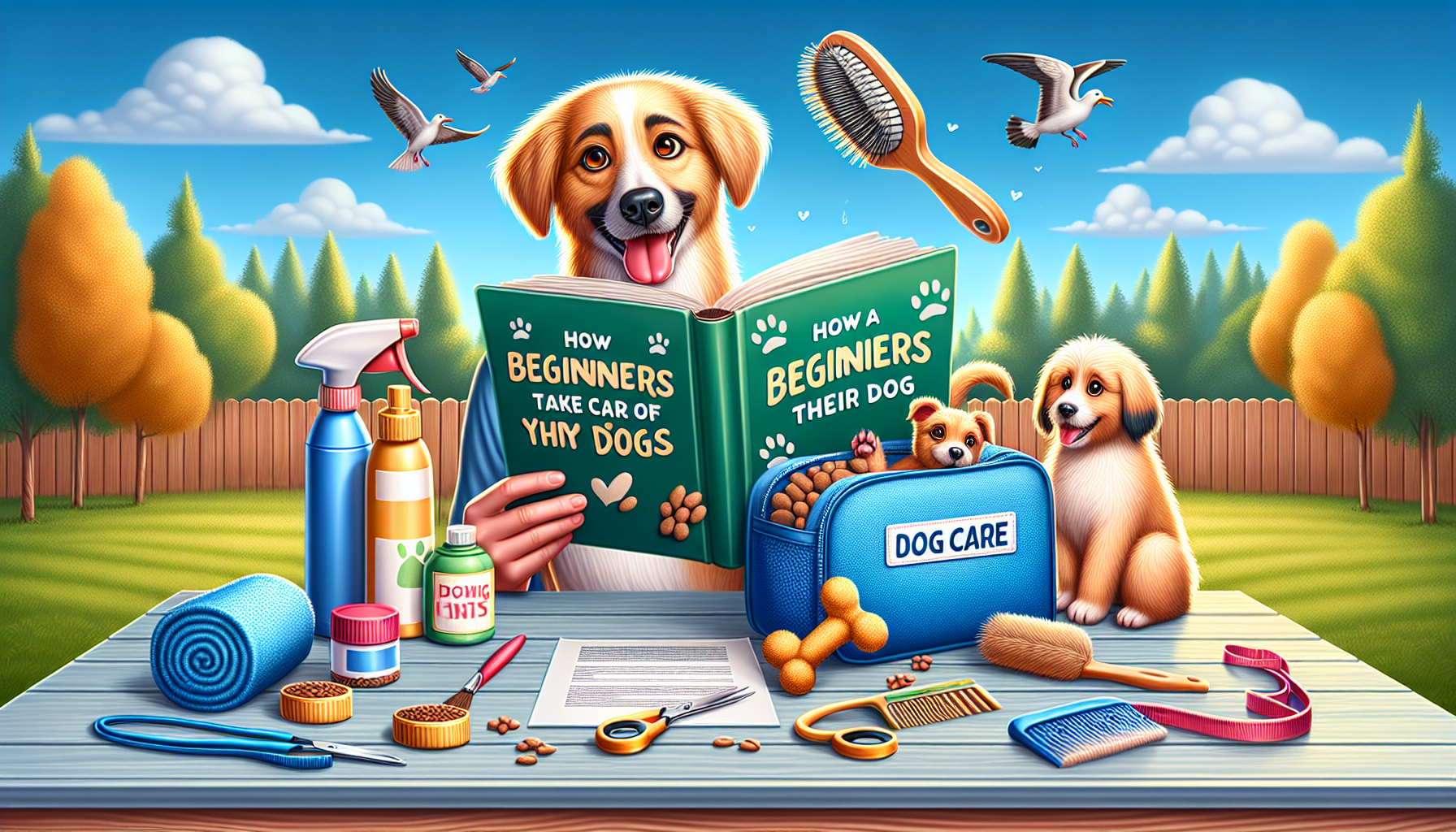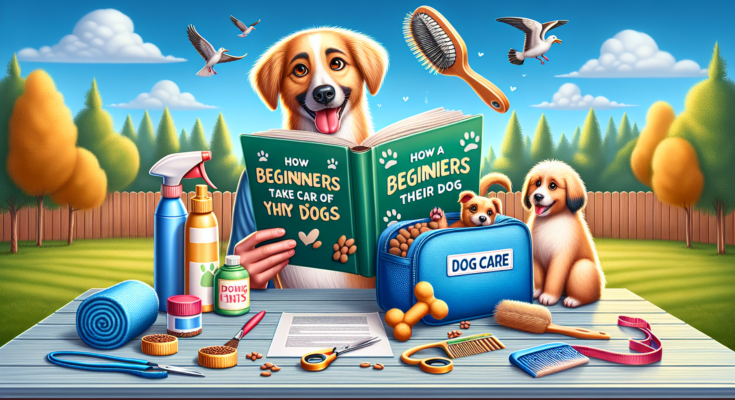Essential Dog Care Tips for Beginners: A Comprehensive Guide
Bringing a dog into your home is an exciting journey filled with love and companionship. Yet, for first-time dog owners, it can also bring a host of questions about how to ensure a healthy and happy life for their new furry friend. Understanding essential dog care tips is crucial in this adventure, as it lays the foundation for responsible pet ownership and a strong bond between you and your canine companion. From puppy training basics to dog grooming essentials, this comprehensive guide will equip beginner dog owners with the necessary tools and knowledge.
As you embark on this rewarding experience, it’s important to grasp the fundamentals of canine care 101. This includes everything from understanding dog behavior and socialization advice to ensuring proper nutrition and exercise. Every aspect of a dog’s life contributes to their overall well-being, making it vital to be informed about pet health care. Knowing how to provide adequate veterinary care tips and learning about the importance of dog exercise will empower you to make informed decisions for your pet’s health.
Moreover, adopting a dog comes with responsibilities that extend beyond feeding and walking. It involves creating a safe environment and being mindful of your dog’s needs for mental and physical stimulation. With dog safety tips and a dog care checklist in hand, you can navigate potential challenges confidently. Prepare to embrace the joys of dog ownership while ensuring your pet’s happiness and health are prioritized.
Key Areas of Focus
- Dog Nutrition Guide: Balanced diets for optimal health.
- Training Your Dog: Effective methods for obedience and socialization.
- Dog Walking Tips: Best practices for enjoyable outings.
- Home Care for Dogs: Creating a comfortable living space.
In this guide, beginner dog owners will discover valuable insights and practical advice designed to enhance their pet care journey. By following these essential dog care tips, you’ll be well on your way to raising a well-adjusted, joyful dog who enriches your life.

Key Takeaways
- Nutrition Matters: Ensure your dog receives a balanced diet with protein, fats, and essential vitamins.
- Regular Vet Visits: Schedule annual check-ups to monitor your dog’s health and catch any potential issues early.
- Exercise is Essential: Provide daily physical activity and mental stimulation to keep your dog healthy and happy.
- Training and Socialization: Start training early to promote good behavior and social skills in your dog.
- Comfortable Living Space: Create a cozy and safe environment for your dog to rest and recharge.
- Grooming Needs: Regular grooming helps maintain your dog’s coat and skin health.
Understanding the Importance of Dog Care
Why Proper Dog Care Matters
Proper dog care is essential for ensuring the health and happiness of your furry friend. It helps prevent diseases, promotes good behavior, and enhances their quality of life. Regular check-ups and a balanced diet are crucial in maintaining their overall well-being.
The Benefits of Being a Responsible Dog Owner
- Healthier Pets: Regular veterinary visits help catch issues early.
- Better Behavior: Training improves obedience and reduces behavioral problems.
- Stronger Bond: Engaging in care routines strengthens the relationship between you and your dog.
Overview of Common Dog Breeds and Their Needs
Different dog breeds have unique requirements. For instance:
| Breed | Exercise Needs | Grooming Needs |
|---|---|---|
| Labrador Retriever | High | Moderate |
| Poodle | Moderate | High |
| Bulldog | Low | Low |
Understanding these differences is key to providing tailored care that keeps your dog happy and healthy.

Selecting a Dog That Fits Your Lifestyle
Assessing Your Living Situation
Before adopting a dog, it is crucial to evaluate your living situation. Consider factors like home size, whether you have a yard, and if pets are allowed in your rental agreement. A spacious home with a backyard can accommodate larger breeds, while apartment dwellers might prefer smaller, low-energy dogs.
Evaluating Activity Levels: High-Energy vs. Low-Energy Breeds
Your lifestyle’s activity level plays a significant role in dog selection. High-energy breeds, such as Border Collies or Labrador Retrievers, require regular exercise and mental stimulation. Conversely, low-energy breeds, like Bulldogs or Basset Hounds, thrive in more relaxed environments and are suitable for less active households.
Considering Size and Space Requirements
The size of the dog is another essential factor. Larger breeds need more space to move comfortably, while smaller breeds can adapt to tighter living conditions. It’s vital to match the dog’s size to your environment to ensure both comfort and happiness.
Must-Have Supplies for New Dog Owners
Becoming a new dog owner is exciting, but it comes with the responsibility of ensuring your furry friend is well-equipped. Here are essential supplies to consider:
Essential Gear: Collars, Leashes, and ID Tags
Start with a comfortable collar and leash that fits your dog properly. An ID tag with your contact information is crucial in case your dog gets lost.
Feeding Supplies: Bowls and Quality Dog Food
Invest in sturdy food and water bowls. Choose high-quality dog food tailored to your dog’s age and breed to ensure optimal health.
Comfort Items: Beds, Blankets, and Toys
Provide a cozy bed and soft blankets to create a safe space for your dog. Engaging toys can help prevent boredom and destructive behavior.
Establishing a Daily Routine for Your Dog
Creating a daily routine for your dog is essential for their well-being and happiness. A structured schedule helps dogs feel secure and less anxious. Here are key components to consider:
Feeding Schedules and Nutrition Guidelines
Establish a consistent feeding schedule by providing meals at the same time each day. This practice supports healthy digestion and metabolism. Choose high-quality dog food tailored to your dog’s age, size, and dietary needs. Consult with a veterinarian to ensure your dog’s nutritional requirements are met.
Exercise Needs: Walks, Playtime, and Socialization
Daily exercise is crucial for a dog’s physical and mental health. Aim for at least one walk per day, supplemented with playtime and socialization. Activities like fetch or visits to the dog park can enhance their social skills and burn off excess energy.
Hygiene Practices: Bathing, Brushing, and Nail Trimming
Maintaining good hygiene is vital for your dog’s health. Regular brushing helps reduce shedding and prevents matting. Schedule baths based on your dog’s breed and activity level. Don’t forget to trim nails regularly to avoid discomfort and potential injuries.
Maintaining Your Dog’s Health
Maintaining your dog’s health is crucial for their happiness and longevity. Regular veterinary visits are essential; dogs should receive vaccinations and check-ups at least once a year. This ensures they are protected from common diseases and allows for early detection of potential health issues.
Understanding Preventive Care
Preventive care includes flea, tick, and heartworm prevention. Using veterinarian-recommended treatments helps protect your dog from these parasites, which can lead to serious health complications. Regularly administering preventive medications is vital for keeping your pet healthy.
Recognizing Signs of Illness
Being aware of the signs of illness is important. Look for changes in behavior, appetite, or energy levels. If your dog shows signs of distress, such as vomiting, diarrhea, or excessive scratching, seek veterinary help promptly. Early intervention can make a significant difference in treatment outcomes.
Essential Training Tips for Dogs
Positive Reinforcement Techniques
Using positive reinforcement techniques is crucial in dog training. This method involves rewarding your dog with praise or treats whenever they exhibit desired behaviors. For instance, if your dog sits on command, immediately reward them. This encourages them to repeat the behavior. Consistency is key; use the same words and tone for commands to help your dog associate specific cues with actions.
Socialization with Other Dogs and People
Socializing your dog is another essential training aspect. Introduce your dog to various environments, people, and other dogs to help them become well-adjusted. Early socialization can prevent behavioral issues later. Arrange playdates or group training sessions to expose your dog to different situations, ensuring a positive experience with new interactions.
Basic Commands Every Dog Should Know
Teaching basic commands is fundamental for every dog. Commands like “sit,” “stay,” “come,” and “down” form the foundation of good behavior. Start with short training sessions, focusing on one command at a time. Gradually increase complexity as your dog learns, reinforcing each command with positive rewards.
Grooming Your Dog: Best Practices
Choosing the Right Brushes for Different Coat Types
Choosing the right brush is essential for effective grooming. For short-haired dogs, a rubber curry brush can help remove loose fur and stimulate the skin. Medium-haired breeds benefit from a slicker brush to untangle knots. Long-haired dogs require a wide-toothed comb to prevent matting and a pin brush for daily care.
Bathing Frequency and Techniques
Bathing your dog should be done as needed, generally every 4-6 weeks. Use a dog-specific shampoo to maintain coat health. When bathing, wet the coat thoroughly and apply shampoo, lathering gently. Rinse well to avoid skin irritation.
Ear Cleaning
Regular ear cleaning helps prevent infections. Use a vet-recommended ear cleaner and cotton balls. Gently wipe the outer ear, avoiding deep insertion.
Teeth Brushing
Dental hygiene is crucial. Brush your dog’s teeth several times a week with toothpaste formulated for dogs. This practice helps prevent plaque build-up and promotes fresh breath.
Grooming Tools
- Slicker Brush
- Wide-Toothed Comb
- Nail Clippers
- Dog Shampoo
- Ear Cleaner
Understanding Dog Behavior
Understanding dog behavior is crucial for any pet owner. Common behavioral issues often stem from lack of training, socialization, or mental stimulation. For instance, barking can indicate boredom or anxiety. Solutions include engaging in regular playtime and training sessions to curb unwanted behaviors.
The Importance of Mental Stimulation
Mental stimulation is as vital as physical exercise for dogs. Activities like puzzle toys, obedience training, and interactive games can keep your dog’s mind sharp. Lack of mental engagement may lead to destructive behaviors, such as chewing furniture or excessive barking.
How to Interpret Your Dog’s Body Language
Dogs communicate through body language. A wagging tail doesn’t always mean happiness; the posture of the tail can signify excitement or aggression. Understanding these signals helps strengthen your bond with your furry friend. Key signs include:
- Relaxed Ears: Indicates a calm and happy dog.
- Raised Hackles: Suggests your dog feels threatened.
- Averted Gaze: Sign of submission or discomfort.
Keeping Your Dog Safe at Home and Outdoors
Creating a Dog-Friendly Home Environment
To ensure your dog’s safety at home, start by creating a dog-friendly environment. Remove hazardous items such as toxic plants, chemicals, and sharp objects. Use baby gates to restrict access to stairs and dangerous areas. Designate a cozy space for your dog with their bed and toys, providing a sense of security. Regularly check for choking hazards like small items on the floor. Keeping your home clean and clutter-free will also prevent accidents.
Safe Outdoor Activities and Precautions
When taking your dog outdoors, always supervise them. Install a secure fence to prevent escapes. Engage in safe outdoor activities like leash walks or fetch in a safe area. Ensure your dog is up-to-date on vaccinations to protect against diseases. Use a harness instead of a collar for better control during walks. Be cautious of hot pavement during summer walks to avoid paw injuries. Always carry water to keep your dog hydrated during outdoor play.
Traveling with Your Dog: Safety and Comfort
Traveling with your dog requires preparation for safety and comfort. Secure your dog in a well-ventilated crate or use a pet seatbelt during car rides. Never leave your dog unattended in a vehicle, especially in extreme temperatures. Plan for breaks during long trips to allow your dog to relieve themselves and stretch. Carry familiar items such as their blanket and favorite toys to reduce anxiety. Make sure to have your dog’s identification tags updated and include a leash for easy handling.
Fostering a Strong Relationship with Your Dog
Building a strong relationship with your dog is essential for their happiness and well-being. Spending quality time together is crucial; dogs thrive on companionship, and regular interaction strengthens your bond. Engage in activities like walks, playtime, and training sessions to create enjoyable experiences that both you and your dog will cherish.
Importance of Quality Time Together
Quality time is vital for trust and understanding in your relationship. Regular routines, such as feeding and walking at the same times each day, help your dog feel secure. This predictability fosters a sense of safety, allowing your dog to relax and build confidence in you as their caregiver.
Engaging Activities to Strengthen Your Bond
- Playtime: Incorporate games like fetch or tug-of-war to keep your dog physically active and mentally stimulated.
- Training Sessions: Use positive reinforcement techniques during training to encourage desired behaviors while strengthening your bond.
- Outdoor Adventures: Explore parks or hiking trails together, providing new experiences that enhance your connection.
Understanding Your Dog’s Needs and Preferences
Every dog is unique, so it’s essential to observe and understand their specific needs and preferences. Pay attention to their body language and reactions to various activities. This knowledge allows you to tailor your interactions, ensuring they are enjoyable and fulfilling for your furry friend.
Conclusion
In conclusion, understanding essential dog care tips is vital for fostering a happy and healthy relationship with your furry friend. Selecting a dog that fits your lifestyle, gathering must-have supplies, and establishing a daily routine are foundational steps every new owner should take. Regular health maintenance and effective training can significantly enhance your dog’s well-being. Grooming practices and comprehending dog behavior will further strengthen your bond. For those considering bringing a dog into a family, check out our post on Choosing the Perfect Starter Dog for Your Kids. Embrace these tips, and enjoy the wonderful journey of dog ownership!
Frequently Asked Questions
1. What are the basic needs of a dog?
Dogs require proper nutrition, exercise, grooming, socialization, and regular veterinary care to ensure their health and happiness.
2. How often should I take my dog to the vet?
It’s recommended to schedule annual check-ups to monitor your dog’s health and vaccinations.
3. What type of food is best for my dog?
A balanced diet should include high-quality protein, healthy fats, carbohydrates, vitamins, and minerals tailored to your dog’s age and activity level.
4. How can I keep my dog mentally stimulated?
Engage your dog with interactive toys, training sessions, and regular playtime to promote mental enrichment.
5. What exercise do dogs need daily?
Most dogs require at least 30 minutes to 2 hours of exercise each day, depending on their breed and energy level.
6. How can I tell if my dog is happy?
Signs of a happy dog include a wagging tail, playful behavior, and a relaxed body posture.
7. Is it important to socialize my dog?
Yes, socialization helps dogs become well-adjusted and reduces anxiety and behavioral issues around other people and pets.
8. How can I maintain my dog’s dental health?
Regular brushing, dental chews, and professional cleanings can help prevent dental disease and maintain good oral hygiene.
References
- Simply For Dogs. (n.d.). How And Why To Establish A Routine For Your Dog. Retrieved from https://simplyfordogs.com/establish-routine-dog/
- Dog’s Best Life. (n.d.). 5 reasons to create a healthy daily routine for your dog. Retrieved from https://dogsbestlife.com/dog-training/daily-routine-for-dogs/
- American Kennel Club. (n.d.). Why Your Dog Needs a Routine at Every Stage of Life. Retrieved from https://www.akc.org/expert-advice/health/why-your-dog-needs-routine/
- Doggyzine. (2024). Canine Wellness: 12 Tips for Keeping Your Dog Healthy and Happy.
- Pet Health Pros. (2024). Comprehensive Guide to Wellness Checks for Dogs.
- Purina Pro Club. (2024). 7 Tips: Preventive Maintenance For Your Dog’s Health.
- The Spruce Pets. (2024). Dog Health Tips – Keeping Your Dog Healthy.
- PetMD. (2024). 8 Tips for a Healthy Dog.
- Life In Dog Years. (2024). Maintaining Your Dog’s Health: A Comprehensive Guide to Caring for Fido.
- BetterVet. (2024). How to Take Care of a Dog: 8 Vet-Recommended Tips.
- Pets R Great. (2024). 11 Essential Dog Care Tips For Every Dog Owner.
- Dog Carely. (2024). What Are the Essential Dog Care Tips for Beginners?.
- Dog Corner. (2024). 100 Essential Life Hacks for Blissful Dog Owners.
- BetterVet. (2024). How to Take Care of a Dog: 8 Vet-Recommended Tips.
- Pet Sweet Joy. (2024). Dog Care Tips for Beginners: Care, Health, and Behavior.
- Forbes Advisor. (2024). 25 Dog Care Tips For Pet Parents.
- Pawster. (2024). A Comprehensive Guide to Basic Dog Care Tips.



